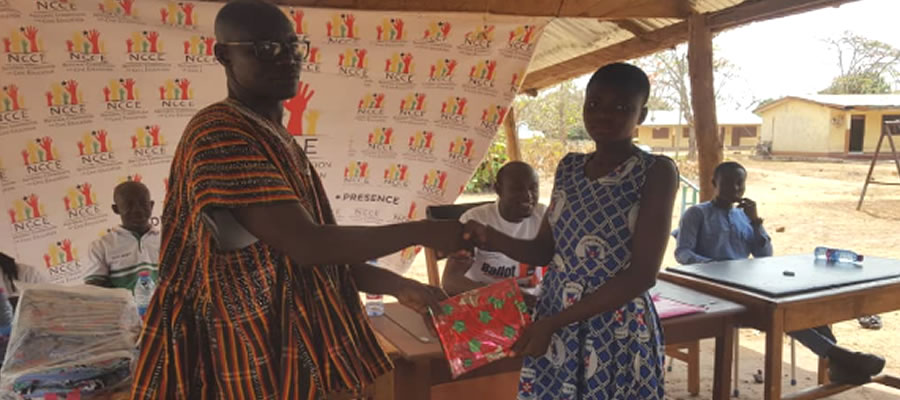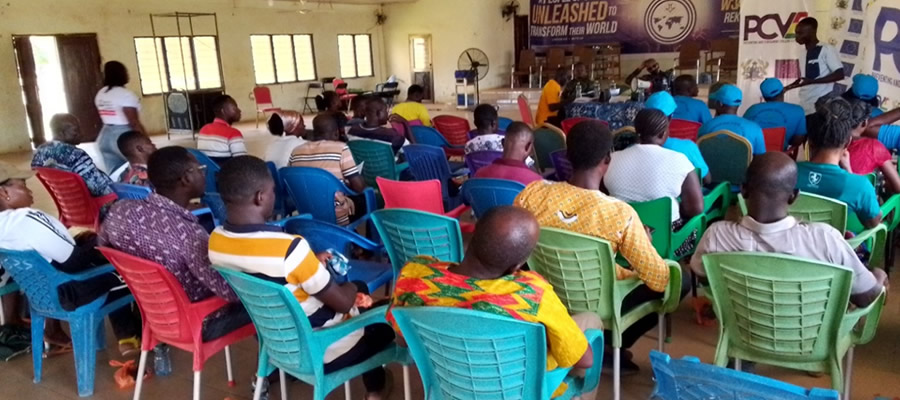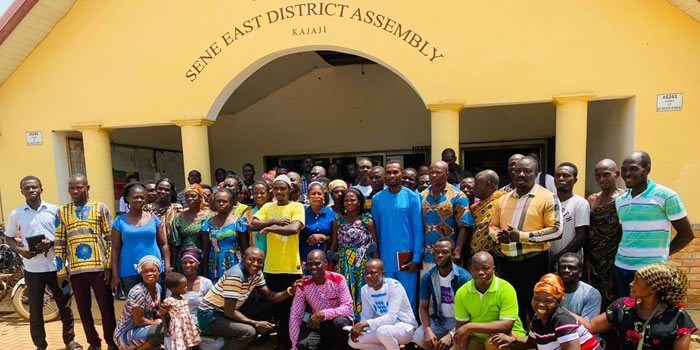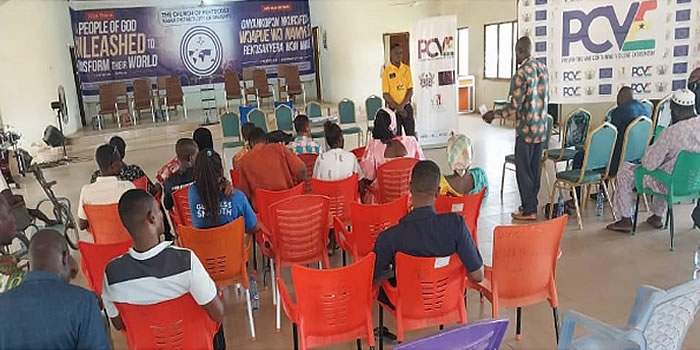

Introduction
Population size and age-sex structure is one of the most basic ways to understand social and economic implications of fertility, mortality and migration dynamics. The changes over time in age and sex composition gives insights into changing phenomenon and highlights in future social and economic challenges as well as prospects. This section discusses the age and sex composition of the district.
Population Size and Distribution
Sene East District has a total population of 61,076 consisting of 52.7 percent males and 47.3 percent females. This trend is different from the regional level where females are more than the males. This development could be attributed to the availability of fertile land in the district which has attracted migrant farmers, mainly males, from other parts of the country. The district is completely rural. Table 2.1 presents the population of the district by age, sex and type of locality. Children under five years constitute 17.5 percent of the total population of the District. Within the male population, children under five years are 5,521 (9.0%) while for the female they are 5,148 representing 8.4 percent of the total population. The table further reveals that, the working population of the district (15-64 years) is 31,592 representing 51.7 percent, indicating that more than half of the population is within the labor force.
The male preponderance in the population is reflected in the high sex ratios in all the age groups except ages 25-29 and 30-34. The general sex ratio for the district is 111.6 males per 100 females. This may confirm the observation that the vast fertile land in the district and the Volta Lake might have attracted many people, mainly males, from other parts of the country. The fact that the sex ratios remain quite high even into the extreme old ages suggests that many males who move into the district to take advantage of the available arable land do not go back eventually.
Age dependency
Dependency ratio is among the key indicators of socio-economic development. It relates the number of dependents: children (0-14 years old) and persons (65 years and older) to the working-age population (15-64 years old). It shows the potential effects of changes in age structure for social and economic development, pointing out broad trends in social support needs. Table 2.2 shows that the District has a dependency ratio of 93.3 which means that for every 100 people in the labor force there are about 93 dependents. This is much higher than the national average of 76.
Population density
Population density refers to the number of people occupying a particular land area at a point in time. This is calculated by dividing the total population of a particular geographical area by the total land area covered. The Sene East District has a population density of 13.9 persons per square kilometer. This shows that, almost 14 persons occupied a square kilometer of land in the district. Compared to the national density of 103.4 persons per square kilometer and a regional average of 58.4, the Sene East District is very sparsely populated.
Age-Sex Structure
Figure 2.1 shows the age-sex structure of the population in the district. The age-sex structure of the district is characterized by a broad base and a narrow apex. This means that, the district’s population is very youthful with few aged people. With increasing age, the age-sex structure looks slightly thinner for the females than for the males, indicating that at older ages, the proportion of females is lower than that of males. For the age groups 0-19 years there are more males than females. The high proportion of the populations aged 0-4 and 5-9 years indicate that the population in the district has the potential to grow for a considerable number of years. This has implications for the economic development of the district. This type of age structure is typical of most developing countries.
Fertility, Mortality and Migration
Fertility, mortality and migration are the three components of population change that determine the size, age-sex composition and distribution of the population at a particular point in time. Data on these three components are critical for planning the overall socio-economic development of a district. This section provides analysis of the fertility, mortality and migration patterns in the district.
Fertility
Fertility refers to the frequency of child bearing among a population. Fertility rate measures the relative frequency with which births occur within a given population and is measured by, among other things, total fertility rate (TFR), general fertility rate (GFR), and crude birth rate (CBR).
The total fertility rate is the average number of children that would be born to a woman by the time she ended child bearing if she were to pass through all her child bearing years conforming to the age-specific fertility rates of a given year. From Table 2.3, the Total Fertility Rate for the district is 4.6 children per woman which is higher than the regional value of 3.6.
The general fertility rate is calculated by dividing the total number of births in a given year by the number of women aged 15 to 49 and multiplied by 1,000. The General Fertility Rate for the district is 138.2, compared with the regional figure of 105.9. This means that 138 children are born to a 1000 women in the district.
Crude birth rate is the number of births per 1,000 persons in a population over a given period of time (i.e. 1 year). It is a ratio of the number of births to the total population. The crude birth rate for the district is 30.4, which is higher than the regional figure of 26.3. The district crude birth rate of 30.4 implies that there are 30.4 live births for every 1000 population in the district.
Children ever born and surviving
The number of children ever born per woman measures the life time and cumulative fertility performance of females in the reproductive age group 15-49 years. About 52,507children have ever been born by women aged 12 years and older and 46,078 are surviving in the district. Table 2.4 shows that the number of children ever born increases with age and gets to the highest point at age 44. Children surviving include all babies born alive by females 12 years and older.
Migration
Migration is the movement of people from one geographical location (original place) to the other (destination). This movement could either be within (internal) or without (external) a country. On the basis of place of birth, anybody whose present place of residence is different from his birth place is described as a migrant. The places of birth and enumeration in a census are important for understanding the internal and external movements of the population in any given territory. This section presents information of birth place by duration of residence of migrants.
Table 2.7 shows that, the district has a total migrant population of 23,609 with 15.8 percent (3,740) born elsewhere in the Brong Ahafo region and the rest born elsewhere other regions. Furthermore, most of the migrants in the district were born in the Volta Region (8,743) followed by Northern Region (3,025) with the least number (154) of migrants born in the Western Region.
In terms of duration of residence it could be said that majority of the migrants in the district are recent. More than half of them (57.0%) have lived in the district for less than 10 years and as much as 38.4 percent have lived in the district for less than five years. This development could be in response to the creation of the area as a new district a few years back.
It must be added, however, that a fifth of the migrants (20.8%) have lived in the district for more than 20 years and a similar proportion (22.2%) have lived there for 10 to 19 years. Similar to the migrants of Ghanaian origin, more than half of the people born outside Ghana (52.1%) have lived in the district for less than five years but nearly a third (30.9%) have lived in the district for more than 10 years. The district’s main resources, fertile land and large water bodies suitable for fishing could be the main attractive force for bringing migrants into the district.
Date Created : 11/17/2017 8:49:23 AM











 facebook
facebook
 twitter
twitter
 Youtube
Youtube
 +233 593 831 280
+233 593 831 280 0800 430 430
0800 430 430 GPS: GE-231-4383
GPS: GE-231-4383 info@ghanadistricts.com
info@ghanadistricts.com Box GP1044, Accra, Ghana
Box GP1044, Accra, Ghana